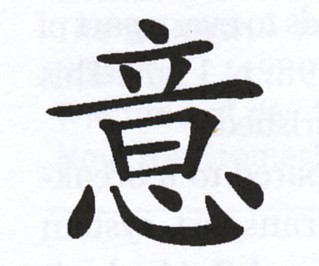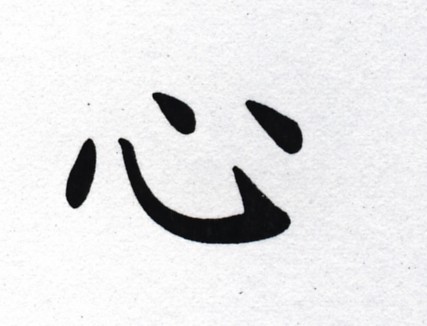Positive Health Online
Your Country

Diagnosis in Chinese Medicine: Intention - The Art of 'Doing Nothing'
listed in chinese oriental medicine, originally published in issue 153 - December 2008
As an acupuncturist I am very aware of the importance of using intention in my practice. Other practitioners, especially those who use bodywork such as Massage, Osteopathy, Chiropractic, Shiatsu, Reflexology or Alexander technique, can also benefit from it. Intention can take us from being good technicians into the realm of healing. This results in greater benefits to the patients, as well as making treating more enjoyable for the practitioner.
The Chinese character yi is widely translated as intention.[1] Intention has been discussed in many famous Chinese Medicine classics. Although, in later texts, yì takes on a more mental meaning, in pre-Han texts (pre +206) it still involves 'the meditation-like bodily practice of 'intending', whereby one opens oneself to the universal flow of qi so as to acquire a luminous awareness of the world.[2]
yi
Research backs up the effect of intention. For example, one experiment found that remote mental intention can influence a person's autonomic nervous system and create changes in skin resistance.[3] In another double-blind study the researcher reported that the growth rate of bacteria could be influenced by conscious intention.[4] Other well-known projects have measured the effects of prayer. One of the most impressive was carried out on 393 coronary care patients in a double-blind trial. The prayed-for patients were five times less likely than control patients to require antibiotics, and three times less likely to develop pulmonary oedema. None of the prayed-for patients require a tracheotomy compared to 12 of the control patients who did required this support.[5]
We may know that intention can influence treatments, but how do we make it work for us? I believe the two main ingredients of intention are a clear outcome and the ability to 'do nothing', relax and let the result emerge by itself.
Being Present
When I say 'doing nothing' I don't mean doing nothing physically. I mean doing nothing internally and having a sense of resting inside. When we do this we can be present to whatever's going on.
The Chinese character for the Heart encapsulates this. It describes an empty space where our shen can reside. This character has no 'flesh' radical as, unlike most other Organs depicted in Chinese Medicine, it is not described as being physical. We can describe this space as 'a state of just being.[6] By resting inside the Heart we can 'do nothing' in a state of calmness.
Ht
Being in the Flow
If practitioners try hard to treat their patients, or try to get the treatment right, it can make them very tense. Trying stops the flow of treatments. Although it can give practitioners the sense that they are doing something useful, in reality more will happen when they do less and let go of the effort. Trying too hard takes the enjoyment out of treating. It can also block our ability to be creative, and stop us finding new ways to deal with problems that emerge in the treatment room.
What is the difference between allowing and trying? Firstly, when we try we are tense. Tension means our vital energy or qi rises to our heads causing us to over-think. Tense muscles also make it more difficult to be in contact with our bodies and disconnect us from our patients. On the other hand, the internal state of allowing is very relaxed. Our qi sinks downwards and we become more conscious of inhabiting our bodies and being comfortable inside them. When we are allowing we will naturally feel relaxed, enabling us to connect with our patients. In this state we are at our most creative and this helps our sense of clarity about how best to carry out the treatment.
An Inner Sense of Focus
As I said earlier, the second ingredient of intention is an inner sense of clarity and focus. I notice that new student practitioners at the College where I work carry out some excellent treatments. I think the efficacy of these treatments is related to the students' intentions. At the start of the clinical work the students discuss their first patient in great depth. This creates great anticipation as well a strong sense of inner certainty and trust that they are going to do the 'right' treatment. The treatment is planned, and they know their supervisor will be there in the event of any problem – so part of them can just relax and get on with it. The resulting intention generated reflects on the treatment in a positive way.
Our ability to diagnose, coupled with relaxation and a strong focus, can create a very powerful state in order to carry out treatments with clear intention.
Our Internal Development
Sometimes we seem to have to struggle first in order to 'let go into the flow'. We might go back and forth between trying and allowing. In time, however, if we work on letting go, it becomes a more deeply engrained habit and wins over trying. Taking up qi gong, yoga, tai chi, meditation or some other body-based 'art' helps us to develop this relaxed state and be inside our bodies. Doing aikido or a 'soft' martial art is also helpful. I remember my sensei (teacher) saying to me 'do nothing' as I learnt a throw. When I stopped trying, relaxed and 'extended my qi' at last the throw just flowed. Many writers, athletes and other artists talk about 'being in the zone'. This is the state where they are relaxed and everything flows effortlessly. Sometimes it comes easily, but there may be some struggle at first as we learn to develop it.
Developing Intention
These are some suggestions to help us to develop our intention:
1. Ask yourself 'am I in a trying mode or am I in an allowing mode?' when you are with a patient. If you are in trying mode you probably feel somewhat tense and uncomfortable. In this case just switch to being mode for that one treatment and watch the result - it could become a good habit!
2. Breathe into your lower abdomen when you have a moment to spare, especially in the treatment room. Getting into this habit helps to lower your centre of gravity. Do this regularly and you will notice increasing relaxation and poise (and it also helps your overall health as well).
3. When treating (or walking or doing any other activity too), feel your connection to the earth. You can do this by feeling your dan tian in your lower abdomen or feeling your feet. You will gradually feel that your qi sinks and you will be more in the present.
4. Don't feel you have to know everything - nobody does! Even embrace the feeling of not knowing when it arises. A state of curiosity and alertness will then arise. It also puts you in the here and now, helps you to learn and also relax.
5. Value sudden 'ah ha!' moments. These are the times when you just know in a flash, and with absolute certainty, what treatment to do. These moments can't be forced. If you act on them your intention will be firmly aligned with your actions.
Developing a relaxed state and a sense of clarity is a life-long process and, as well as benefiting treatments, it also increases our health. Happily I will be continuing to develop these states for the rest of my life.
References
1. Five Elements Constitutional Acupuncture. Ch 12 page 118. Churchill Livingstone. 2004.
2. Scheid V and Bensky D. Medicine is Signification – Moving Towards Healing Power in the Chinese Medical Tradition. European Journal of Oriental Medicine 2(6), pp 32-41.
3. Braud W. On the use of living target systems in distant mental influence research. In L Coly (Ed.). Psi research methodology: A re-examination. New York: Parapsychology Foundation (in press). A total of 16 pre-planned sessions were conducted with seven persons acting as mental influencers and ten acting as the remote targets of influence. Influencers were instructed to either calm or activate a remote person's skin resistance in randomly assigned 30-second periods over a 32-minute session. Analysis showed a significant tendency for skin resistance to be higher during activating periods and lower during calm periods. 1993.
4. Nash CB. Psychokinetic control of bacterial growth. Journal of American Soc Psychical Res. 51: 217-221. 1982.
5. Byrd RC. Positive therapeutic effects of intercessory prayer in a coronary care unit population. Southern Medical Journal. 81(7), 826-829. The design and the results of the Byrd study are impressive, and even sceptical commentators seem to agree on the significance of the findings. 1988.
6. Five Elements Constitutional Acupuncture. Ch 12 page 88.Churchill Livingstone. 2004.
Comments:
-
No Article Comments available